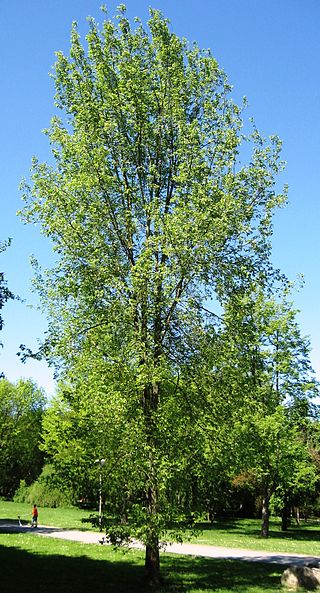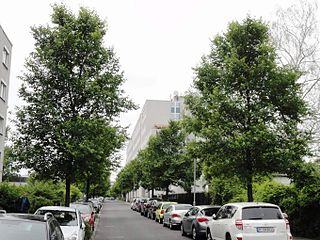
Ulmus rubra, the slippery elm, is a species of elm native to eastern North America. Other common names include red elm, gray elm, soft elm, moose elm, and Indian elm.

Ulmus pumila, the Siberian elm, is a tree native to Asia. It is also known as the Asiatic elm and dwarf elm, but sometimes miscalled the 'Chinese elm'. U. pumila has been widely cultivated throughout Asia, North America, Argentina, and southern Europe, becoming naturalized in many places, notably across much of the United States.

Ulmus davidiana var. japonica, the Japanese elm, is one of the larger and more graceful Asiatic elms, endemic to much of continental northeast Asia and Japan, where it grows in swamp forest on young alluvial soils, although much of this habitat has now been lost to intensive rice cultivation.

Ulmus 'New Horizon' is an American hybrid cultivar raised by the Wisconsin Alumni Research Foundation (WARF), from a crossing of the Japanese Elm clone W43-8 = 'Reseda' with Siberian Elm clone W426 grown from seed collected from a street tree at Yankton, South Dakota. As selection 'W917' it is a sibling of 'Rebona'. Tested in the US National Elm Trial coordinated by Colorado State University, 'New Horizon' averaged a survival rate of 74% after 10 years. 'New Horizon' was patented in the US in 1994, while in Europe, it is marketed as one of the 'Resista' elms protected under EU breeders' rights.

The Dutch hybrid elm cultivar Ulmus × hollandica 'Groeneveld' was cloned in 1949 at the De Dorschkamp Institute, Wageningen, and released in 1963 in response to the earlier, less virulent form of Dutch elm disease that afflicted Europe shortly after the First World War. The cultivar was derived from a crossing of Dutch clones '49', and '1', a Field Elm Ulmus minor found in central France and marketed by the Barbier nursery in Orléans.

Ulmus 'Homestead' is an American hybrid elm cultivar raised by Alden Townsend of the United States National Arboretum at the Nursery Crops Laboratory in Delaware, Ohio. The cultivar arose from a 1970 crossing of the Siberian Elm Ulmus pumila with the hybrid N 215, the latter grown from seed sent in 1960 to the University of Wisconsin-Madison elm breeding team by Hans Heybroek of the De Dorschkamp Research Institute in the Netherlands. Tested in the US National Elm Trial coordinated by Colorado State University, 'Homestead' averaged a survival rate of 85% after 10 years in the US National Elm Trial. However, planting of the tree was not recommended, owing principally to its 'ugly' shape and susceptibility to Southwest injury. 'Homestead' was released to commerce without patent restrictions in 1984.

Ulmus 'Regal' is an American hybrid elm cultivar developed by the University of Wisconsin–Madison and released in 1983. 'Regal' was derived from seeds arising from the crossing of the Dutch hybrid clones 'Commelin' and '215' sent in 1960 by Hans M. Heybroek of the Dorschkamp Research Institute for Forestry & Landscape Planning, Wageningen, Netherlands.
The Chinese elm cultivar Ulmus parvifolia 'Chessins' is a compact lacebark elm used in landscaping. Krüssmann (1976) states that it was raised in Japan.

The Siberian elm cultivar Ulmus pumila 'Dropmore' was grown from seed collected in Harbin, Manchuria, China, by F. L. Skinner, of Dropmore, Manitoba. Green reported (1964) a suggestion to merge the Siberian elm cultivars 'Harbin' and 'Manchu' with 'Dropmore', as all came from the Harbin area. In the event, 'Dropmore' appears to have superseded these earlier cultivars.
The Siberian Elm cultivar Ulmus pumila 'Park Royal' is a cold-hardy selection raised by the Sheridan Nursery, Toronto, Ontario, Canada.

The hybrid elm cultivar Ulmus 'Den Haag' is a Dutch development derived from a chance crossing of the Siberian Elm cultivar Ulmus pumila 'Pinnato-ramosa' and the Belgian Elm Ulmus × hollandica 'Belgica'. S. G. A. Doorenbos (1891-1980), Director of Public Parks in The Hague, finding that seeds he had sown in 1936 from the Zuiderpark 'Pinnato-ramosa' had hybridized with the local 'Belgica', selected six for trials. The best was cloned and grafted on 'Belgica' rootstock as 'Den Haag'; it was planted first in that city, then released to nurseries elsewhere in the Netherlands. The other five were also planted in The Hague.
The hybrid elm cultivar Ulmus 'Hamburg' was originally raised by the Plumfield Nurseries, Fremont, Nebraska, circa 1932, after its discovery by Mr. Lloyd Moffet in a bed of Siberian Elm Ulmus pumila seedlings from Tekamah. It was later marketed by Interstate Nurseries, Hamburg, Iowa, from 1948, as 'Interstate's New Hamburg Hybrid Elm'. Green stated that it was originally said be a hybrid of Ulmus pumila and Ulmus americana, but the Hamburg Nurseries of Iowa made no such claim for it in their catalogues from 1948 onwards. It is now considered more likely that Ulmus rubra was the male parent, as it was also known as 'Hybrid Chinese Elm', and therefore probably synonymous with Plumfield Nurseries' 'Hybrid elm' of the same date, a known crossing of U. pumila and U. rubra, – and so, perhaps, also synonymous with Ulmus × intermedia 'Fremont', an elm of the same parentage found a little later in Plumfield Nurseries.
The hybrid elm cultivar Ulmus × intermedia 'Rosehill' is an American hybrid cultivar originally raised by the Rose Hill Nurseries of Kansas City, Missouri, as Ulmus 'Rose Hill', without species names, from a selection of Ulmus pumila × Ulmus rubra seedlings made in 1951.

The Chinese Elm cultivar Ulmus parvifolia 'Hokkaido' is an older cultivar of Japanese origin.

Ulmus 'Rebona' is an American hybrid cultivar raised by the Wisconsin Alumni Research Foundation (WARF) as selection 'W916', derived from a crossing of Japanese Elm clone W43-8 = 'Reseda' with Siberian Elm clone W426 grown from seed collected from a street tree at Yankton, South Dakota. The tree was registered in 1993 by Conrad Appel KG, of Darmstadt and is a sibling of 'New Horizon'. In Europe, 'Rebona' is marketed as a Resista elm protected under E U breeders' rights.

Ulmus 'Recerta' is an American hybrid cultivar raised by the Wisconsin Alumni Research Foundation (WARF) as selection '196-5' from seed obtained from a Siberian Elm Ulmus pumila in Volgograd, Russia; the male parent deduced as the Field Elm Ulmus minor.

The Siberian elm cultivar Ulmus pumila 'Pinnato-ramosa' was raised by Georg Dieck, as Ulmus pinnato-ramosa, at the National Arboretum, Zöschen, Germany, from seed collected for him circa 1890 in the Ili valley, Turkestan by the lawyer and amateur naturalist Vladislav E. Niedzwiecki while in exile there. Litvinov (1908) treated it as a variety of Siberian elm, U. pumilavar.arborea but this taxon was ultimately rejected by Green, who sank the tree as a cultivar: "in modern terms, it does not warrant recognition at this rank but is a variant of U. pumila maintained and known only in cultivation, and therefore best treated as a cultivar". Herbarium specimens confirm that trees in cultivation in the 20th century as U. pumilaL. var. arboreaLitv. were no different from 'Pinnato-ramosa'.
The Japanese Elm cultivar Ulmus davidianavar.japonica 'Reseda' is an American cultivar raised by the Wisconsin Alumni Research Foundation (WARF) as clone no. 43–8. 'Reseda' was grown from seed sent from Hokkaido, Japan, in the late 1950s. Although not released in its own right, it was destined to become the female parent of the highly successful hybrid cultivars 'New Horizon' and 'Rebona'.

The Ulmus pumila cultivar 'Aurescens' was introduced by Georg Dieck at the National Arboretum, Zöschen, Germany, circa 1885. Dieck grew the tree from seed collected in the Ili valley, Turkestan by the lawyer and amateur naturalist Vladislav E. Niedzwiecki while in exile there. Dieck originally named the tree U. pinnato-ramosaf.aurescens.















